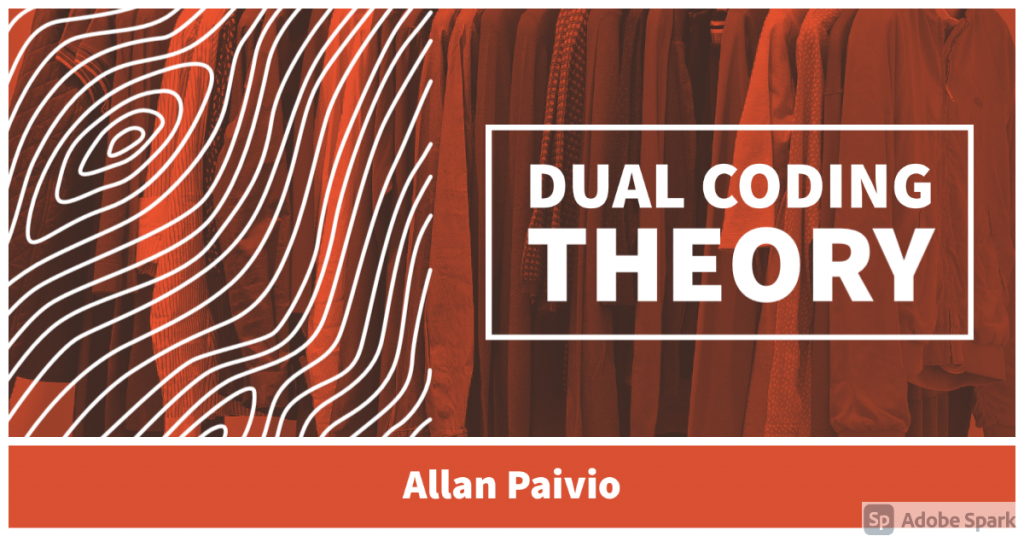
Hoe werkt ons geheugen en hoe kunnen we beter leren ? Dit heeft te maken met hoe onze hersenen functioneren bij het verwerken van informatie. Allan Paivio (1969) heeft hier met zijn Dual Coding Theory een verklaring voor.
Paivio, A.(1969), Mental imagery in associative learning and memory. Psychological Review, 76, 241-263.
Clark, J. M., & Paivio, A. (1991). Dual coding theory and education. Educational psychology review, 3(3), 149-210.
“Het werkgeheugen bestaat uit twee cognitieve werkruimtes: de een codeert en verwerkt beelden en gebeurtenissen (non-verbale informatie) terwijl de andere dat doet met taal (verbale informatie). Door beide delen van het werkgeheugen aan te spreken, verwerk je het dubbel zo sterk. Vervolgens wordt verbale en non-verbale (visuele) informatie afzonderlijk opgeslagen in het langetermijngeheugen. Deze twee systemen zijn met elkaar verbonden.”
Zie: https://leer.tips/tip/dual-coding/
https://www.learningscientists.org/
Beelddenken is een mythe
Woord én beeld leren samen dus beter dan een van beide. Paivio’s theorie betekent voor het onderwijs dan ook: bevorder dat leerlingen beide systemen benutten, want dan onthouden en dus leren ze beter. En dat kan door nieuwe informatie zowel in woord als beeld aan te bieden.
De DCT maakt daarmee korte metten met het vermeende onderscheid tussen beelddenkers en taaldenkers. Dat de een het beste via beelden zou leren en de ander via woorden, is een misvatting. Iedereen gebruikt beide systemen en iedereen heeft baat bij dubbel coderen. Je zou leerlingen tekortdoen door ze eenzijdig beeld of taal voor te schotelen. Hoe vaker leerlingen de twee systemen in samenhang gebruiken, hoe sterker het spoor in het geheugen.
Uit: https://didactiefonline.nl/artikel/beter-inprenten
Cognitieve psychologen hebben doorheen de jaren zes strategieën beschreven die het leren versterken in verschillende situaties. Er is veel evidentie ontstaan voor deze strategieën. Dual Coding behoort tot deze strategieën naast
- Spacing or spreading out learning opportunities over time improves learning
- Interleaving basically means jumbling up ideas. Students learn more when they can switch between different topics. Doing this helps students learn the similarities and differences between different ideas.
- Retrieval practice involves bringing information to mind from memory.
- Concrete examples are often used by instructors. Concrete information is easier to remember than abstract information, and so concrete examples foster learning
- Elaboration involves asking “how” and “why” questions about a specific topic, and then trying to find the answers to those questions. The act of trying to describe and explain how and why things work helps students understand and learn.
Zie: https://www.learningscientists.org/blog/2020/5/7-1
Weinstein, Y., & Sumeracki, M. A. (2019). Understanding how we learn: A visual guide. London, UK: David Fulton, Routledge.
Allan Paivio, Dual Coding Theory and education.
Draft chapter for the conference on “Pathways to Literacy Achievement for High Poverty Children,” The University of Michigan School of Education, September 29-October 1, 2006.
Pdf bestand van het artikel : https://www.researchgate.net/publication/225249172
Zie ook: Clark, J.M., Paivio, A. Dual coding theory and education. Educ Psychol Rev 3, 149–210 (1991). https://doi.org/10.1007/BF01320076
“The research demonstrates that concreteness, imagery, and verbal associative processes play major roles in various educational domains: the representation and comprehension of knowledge, learning and memory of school material, effective instruction, individual differences, achievement motivation and test anxiety, and the learning of motor skills. DCT also has important implications for the science and practice of educational psychology — specifically, for educational research and teacher education. We show not only that DCT provides a unified explanation for diverse topics in education, but also that its mechanistic framework accommodates theories cast in terms of strategies and other high-level psychological processes.”